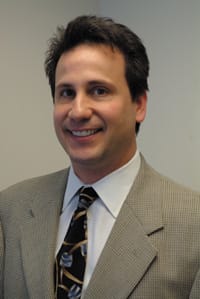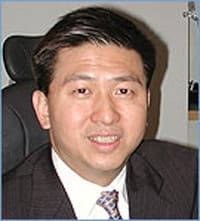Delving into the Problem of
Glaucoma Patient Noncompliance
The causes and solutions are different
than you might think.
BY ROCHELLE NATALONI
At a time when glaucoma treatment advances are coming at a steady clip, one variable remains: patient compliance. A significant portion of glaucoma patients do not adhere consistently to their prescribed medication regimen.
"Problems with compliance continue primarily due to the nature of the disease," says Robert Noecker, M.D., M.B.A., director of the Glaucoma Service at the University of Pittsburgh Medical Center. "Even if patients have relatively advanced disease, they usually don't perceive it as getting worse. There's not a lot of instant gratification here because all these patients can do is take preventative measures. Frankly, the therapy usually has more immediate side-effects than the glaucoma does. It's this insidious, subtle nature of the disease that lends itself to noncompliance."
Drug side-effects and cost are two other reasons considered primarily responsible for noncompliance. However, the specialists interviewed for this article say that when patients fully grasp the concepts of IOP control and glaucoma treatment as investments in their future sight, they are willing to withstand side-effects in exchange for pressure control.
"We read a lot in the literature about patients not complying because of the cost of medications or the side-effects, and that is true to a degree," says Thomas E. Bournias, M.D., assistant clinical professor of ophthalmology, Northwestern University Feinberg School of Medicine, and director of Northwestern Ophthalmic Institute. "But it's not just an economic issue. All of the companies have programs that provide medication at reduced cost or even free, and most patients have some form of prescription drug coverage. Also, it's not just because of side-effects. With the majority of today's glaucoma drugs, most of the side-effects are local to the eye and not serious, and if they are bothersome, the patient has alternatives. And it's not just the patients' level of education about the disease either. It's their level of concern, and that really comes from what we tell them, and how we inform them," he says.
James C. Tsai, M.D., M.B.A., of the Edward S. Harkness Eye Institute at Columbia University in New York, suggests that lifestyle factors probably play a greater role in noncompliance than either drug side-effects or cost. "We're often frustrated by our patients' lack of compliance and wonder why they can't remember to take one or two eye drops a day," Dr. Tsai says. "But studies show that the average glaucoma patient has three other chronic diseases for which he or she has to take at least 4 additional medications. So, it's not just one or two drops that they have to remember."
|
|
|

-- Thomas E. Bournias, M.D. |
|
Dr. Tsai and former colleagues from Vanderbilt University in Tennessee designed a study to systematically identify and describe the obstacles to medication adherence for patients with glaucoma, i.e., develop the taxonomy of barriers. (Tsai JC, McClure CA, Ramos SE, et al. Compliance barriers in glaucoma: a systematic classification. J Glaucoma 2003; 12: 393-398.) Subjects were asked open-ended questions, and 71 unique situational obstacles (i.e. reasons for noncompliance) were reported. These were then grouped into four separate categories: situational/environmental factors; medication factors; patient factors; and provider factors. Situational and environmental factors accounted for 35 out of the 71 reasons.
"In the literature in the past, there was an emphasis on patient education suggesting that if we only educated patients better than they would be 100% compliant," Dr. Tsai says. "The reasoning for this was if patients knew that glaucoma is a blinding disease, they'd automatically remember to take their medications, but the reality is that in our complex world, noncompliance may be due to environmental factors."
Some of the environmental factors that the study subjects said influenced their lack of compliance were changes in routine when a spouse died, and schedule disruptions when the subject or one of their family members was hospitalized. "We wanted to publish a taxonomy to assist providers in developing interventions that will optimize patient education and problem-solving," Dr. Tsai explains. "Because that's what patients and physicians have to work together on: a way to solve the problem of noncompliance. This solution may include figuring out ways for some patients to remember to take their drops, or finding someone to come over and assist in taking drops in other patients. The solution is unique for every patient."
|
|
|
|
-- James C. Tsai, M.D., M.B.A. |
Education Plus Communication
Education is the first step. "I educate the patients. I don't delegate it," Dr. Bournias says. "We talk about every aspect of the condition. That has improved compliance, resulting in better stability of the glaucoma and less need for surgical intervention." Education, however, must be dynamic and include two-way communication. Here are examples of strategies practices are using to improve compliance:
Give patients concrete parameters for judging their condition. Dr. Noecker shows patients images of their optic nerve, pointing out the thinning as what needs to be stopped. "Simple things like this have provided a big advantage in helping patients understand," he says. "Now they ask, 'How's my nerve doing?' instead of just asking what their eye pressure is. If a patient asks about some parameter of his or her therapy, that's a sign that the patient is engaged. There's a big difference between the patient who is engaged vs. the one who hasn't taken the drops and the one who does so only because he's been told to."
|
|
|
|
-- Robert Noecker, M.D., M.B.A. |
|
Ask questions. "The first thing you have to do is to elicit from patients the reasons that they are noncompliant," Dr. Tsai says. "Be as nonconfrontational and nonaccusatory as possible. Once patients understand that you as the physician will work with them to solve their problems, they'll be more willing to trust you with the information."
During follow-up visits, Theodore Krupin, M.D., of Northwestern University's Feinberg School of Medicine, asks patients specific questions, such as "what drops are you taking?" and "when are you taking them?" If patients are asked only if they are "taking their medications," they usually say "yes." But if they're asked specific questions, the doctor is more likely to find out what's really happening.
"We have a technician who goes in with the patient first and asks all the questions about medications and times, and then I go in and ask all the questions again," Dr. Krupin says.
Dr. Noecker tries to pinpoint a unique motivating factor that will help each patient comply with instructions. "It's useful to identify what's important to each person," he says. "Talking about driving to one person may not be a big deal, but it may be the most important motivating factor to the next person. Finding out as much as possible about the patient's daily life can help. Sometimes it's easier for a patient to take a drop in the morning instead of at nighttime. If you find that out, you can advise him or her accordingly."
Don't make assumptions about what patients know. "We can't make assumptions even if it's about something as simple as prescribing one drop a day," says Dr. Tsai. "Often times, patients don't know the correct method to take their drops, so they need instruction. Or, when we ask patients to take a drop twice a day, we can't assume that they understand that this means approximately 12 hours apart. Some patients might think that twice a day means now and then perhaps the second dose an hour from now."
Dr. Tsai finds that writing out explicit instructions, based on the patient's daily routine, (including the times that the drops should be taken) is helpful to some, but not to others. "It's not an exact science," he says. Dr. Tsai also says it makes a difference to explain the rationale behind instructions like closing eyelids after instilling a drop.
|
|
|
|
-- Theodore Krupin, M.D. |
Help patients develop a routine. Dr. Krupin provides patients with a sheet that lists which medication they should be using in which eye, and even separates out each medication by the color of the cap. "We try to work with patients to develop a routine for them, and we often work with their family members so they have a support mechanism," he says.
Understand patient limitations. "If a patient always forgets a drop that is prescribed for a particular time of the day, I might move the time up so that he or she at least gets it in daily, even though it might not be the optimal timing," Dr. Tsai says. "If the physician is too rigid about the time of day the drops need to be taken, patients may not be able to fulfill this request and that's the worst possible scenario.
Eliminate surprises. Dr. Noecker says telling patients what to expect can make all the difference, particularly with respect to medication side-effects. "Eliminating surprises improves compliance," he says. "If they start with a prostaglandin or prostamide, I tell them they're going to get a red eye the next morning, and their eyes may be a little scratchy. I tell them it's normal and temporary and that the vast majority of people who stay with this type of therapy are successful. Also, I acknowledge the cost of medications so they don't get some kind of economic surprise."
In addition, "I let patients know that they have control. The control they have is the therapy, and if they take the therapy, it can prevent them from getting worse."
Simplify regimens whenever possible. "Our goal should be to figure out ways to make it easier," says Dr. Tsai.
Learning More all the Time
While nonadherence to glaucoma medication regimens continues to be a problem, ophthalmologists are developing a clearer picture of the nuances of noncompliance. In turn, they're able to implement strategies that change this behavior and help patients realize the full benefits of the pharmaceuticals that can slow the disease's progression.











